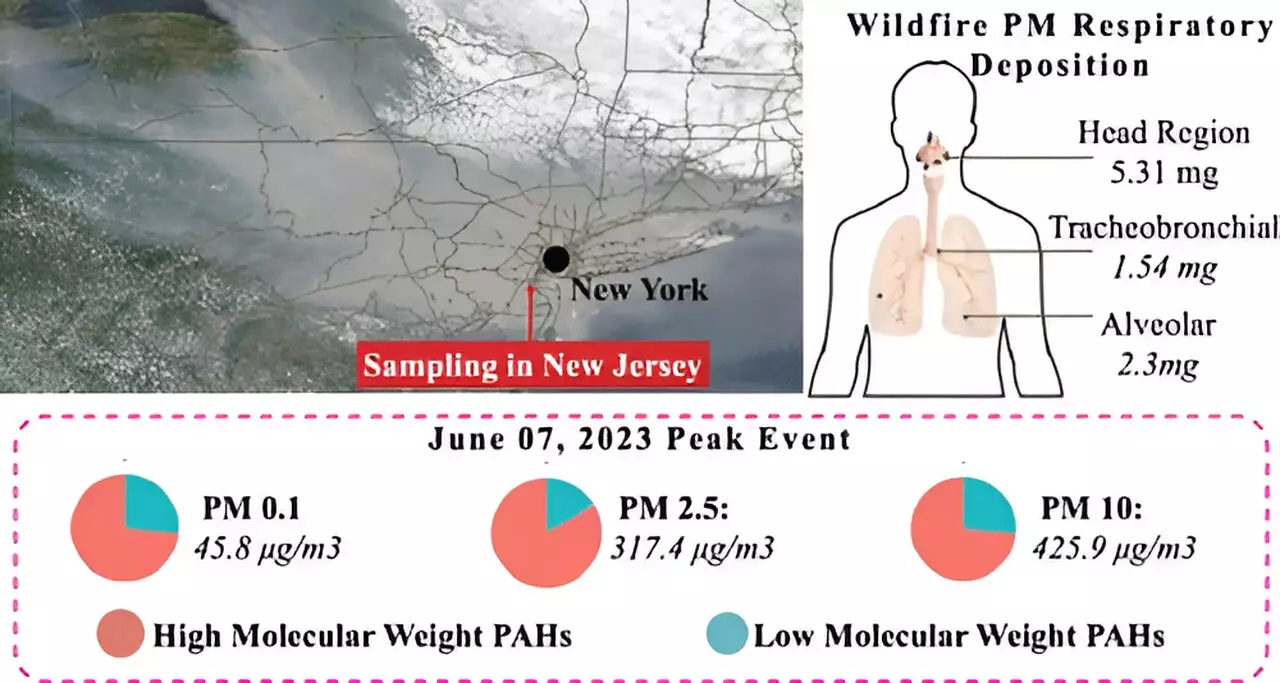In recent years, the increase in climate-driven wildfires has emerged as a crucial global concern, particularly in densely populated regions. A recent study conducted by Rutgers researchers has shed light on the stark realities of wildfire pollution, revealing that emissions from such infernos can travel significant distances, jeopardizing air quality for millions of residents, particularly in the Northeast United States. This investigation denotes the profound health implications associated with particulate matter, highlighting the urgent need for public awareness and policy intervention.
Wildfires are no longer confined to remote areas; their effects can instantly resonate in urban centers where air quality is already compromised. The Rutgers study, recently published in *Environmental Science & Technology*, analyzed particulate matter stemming from a major wildfire in June 2023, which impacted over 100 million people in the Northeast. Lead author Jose Guillermo “Memo” Cedeño Laurent emphasized that particulate matter, particularly from wildfires, significantly contributes to health issues worldwide. “In the U.S., climate change-driven wildfires are reversing decade-long improvements in ambient air quality,” he asserted.
The researchers uncovered alarming associations between wildfire pollution and an uptick in emergency room visits for respiratory and cardiovascular issues. However, while the epidemiological connections are increasingly documented, the underlying mechanisms of these health impacts remain inadequately understood. This study serves as a critical step in elucidating such relationships, as it offers the first comprehensive chemical and physical analysis of wildfire-related particulate matter in this heavily populated region.
The Rutgers team employed advanced physicochemical techniques to investigate the particulate matter, revealing a troubling presence of high molecular weight polycyclic aromatic hydrocarbons (PAHs)—known carcinogens—during the peak of the fire event. The sheer volume of ultrafine and fine particulate matter observed was nearly ten times higher than national air quality standards, marking a historical deviation in pollutant levels and highlighting the potential for adverse health impacts.
Senior author Philip Demokritou added urgency to the findings, noting that these ultrafine particles, due to their diminutive size, are adept at penetrating deep into lung tissues, amplifying the risk of serious health complications. The research posited that a 72-hour exposure period could lead to over 9 micrograms of these harmful particles being deposited in the lungs—figures that warrant serious concern and prompt interventions in public health policy.
The implications of this research extend far beyond immediate health concerns. It lays the groundwork for further studies aiming to unravel the complexities of how wildfire-related particle composition affects various organs, including the lungs, heart, brain, and reproductive systems. Coordinated research involving institutions like Rutgers Robert Wood Johnson Medical School and Brigham and Women’s Hospital indicates a multi-disciplinary approach toward understanding these impacts, showcasing a collaborative effort among scientists and medical experts.
Cedeño Laurent’s acknowledgment of the study’s role in guiding ongoing mechanistic studies underscores the imperative for further exploration into the health ramifications of wildfire smoke, pushing towards a more refined understanding of its effect on human physiology.
In light of the study’s revelations, there is a pressing need for public health officials to wrestle with the implications of these findings. The data can help assess risk and foster the development of improved strategies to protect communities vulnerable to air quality deterioration, especially those already suffering from elevated pollution levels.
The researchers stress that the understanding of wildfire-related air pollution must evolve to meet contemporary challenges. Acknowledging the distinct attributes of wildfire emissions, as compared to typical pollution sources, is critical in forming effective interventions aimed at safeguarding population health.
The Rutgers research not only depicts a dire public health crisis stemming from wildfire pollution but also prompts a broader dialogue regarding climate change and environmental degradation. As urban centers grapple with the ramifications of increased wildfires and associated air pollution, it becomes imperative to mitigate these effects through informed policies and community engagement. The findings underscore an urgent call to action: to rethink approaches to environmental health, embrace research, and prioritize adaptive measures in a rapidly changing climatic landscape.


Leave a Reply